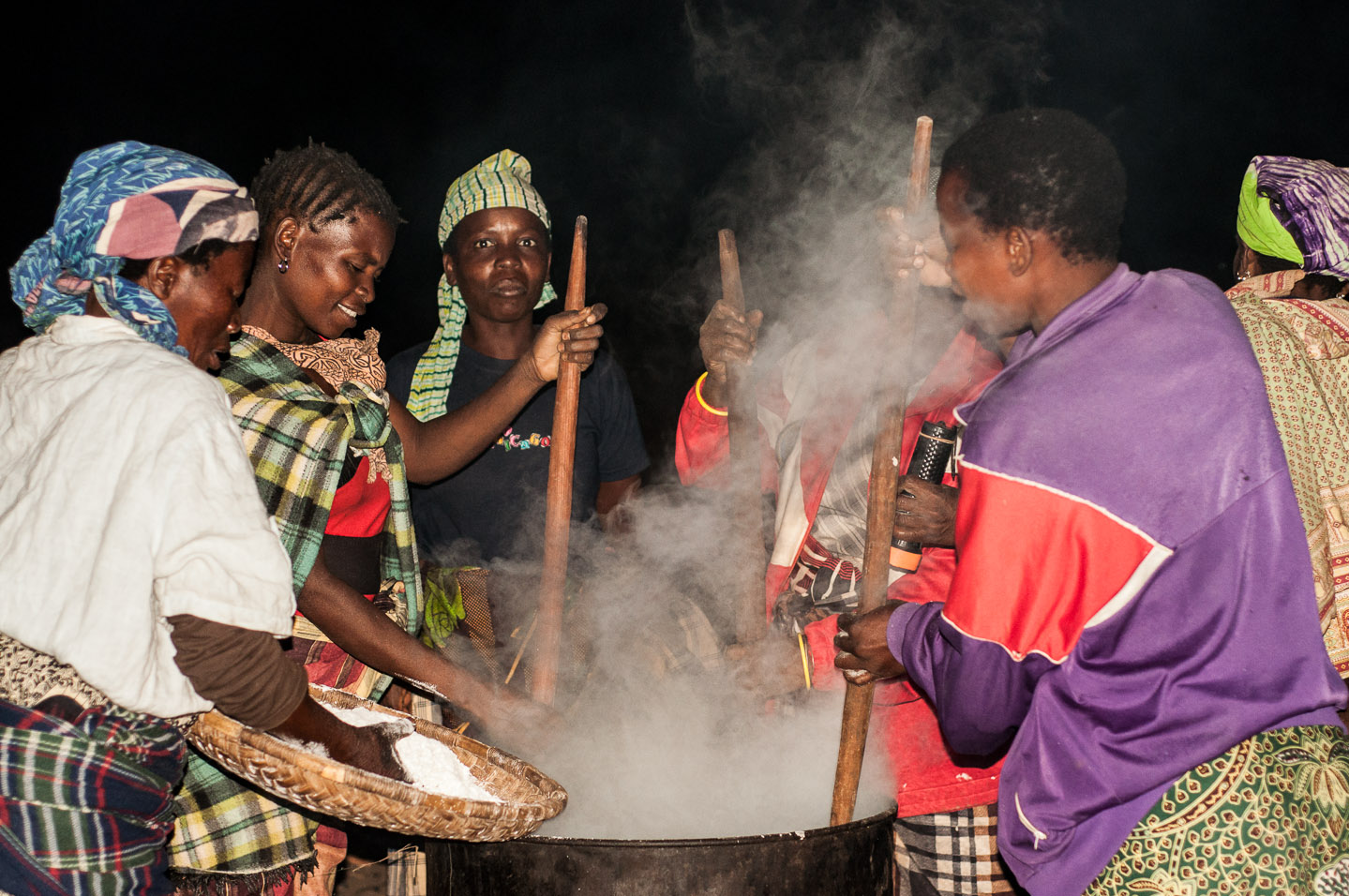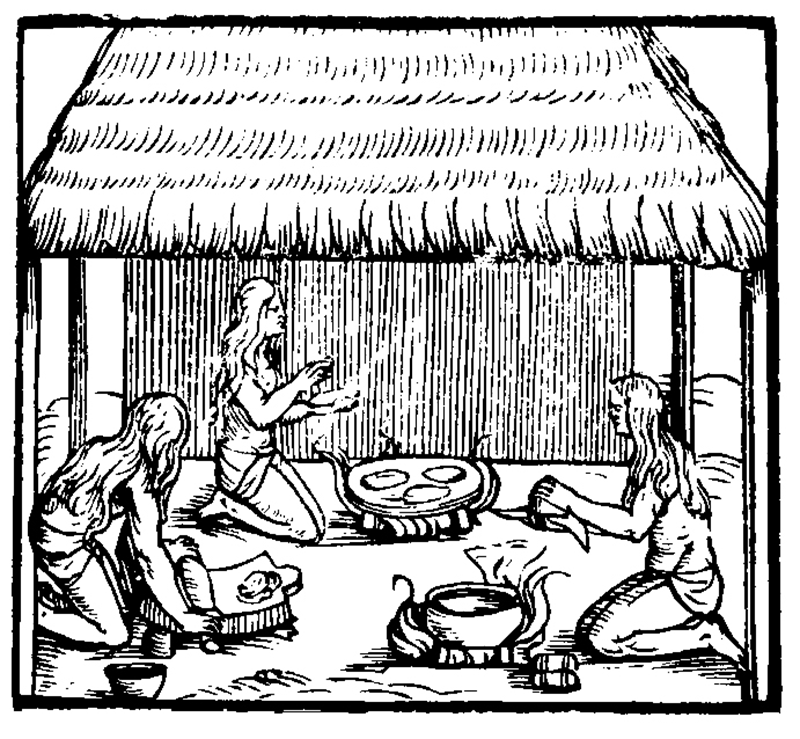|
Kondowole
Kondowole is a staple of Malawian cuisine that is eaten predominantly in the northern region of Malawi. It is made from cassava flour and water. It is a very sticky meal and resembles that of the Malawian nsima, Tanzanian ugali, or English posho. It is mostly cooked on the floor because of its texture as it is normally tough to run a cooking stick through hence a lot of strength is needed. Kondowole is normally eaten with fish; fish in Malawi ranges from "utaka" (pronounced "u-ta-ka") and "chambo" (a famous fish from Lake Malawi). Kondowole is not a meal that can be made in bulk because of its consistency and texture, therefore is not as frequently eaten as nsima Ugali or Posho or sima (for others, see ) is a type of maize meal made from maize or corn flour in several countries in Africa. Sima is sometimes made from other flours, such as millet or sorghum flour, and is sometimes mixed with cassava flour. .... Preparation of Kondowole flour To prepare Kondowole: 1) First peel t ... [...More Info...] [...Related Items...] OR: [Wikipedia] [Google] [Baidu] |
Malawian Cuisine
Malawian cuisine includes the foods and culinary practices of Malawi. Tea and fish are popular features of Malawian cuisine.Food Malawi Embassy Sugar, coffee, corn, potatoes, sorghum, cattle and goats are also important components of the cuisine and economy. is a source of fish including ''chambo'' (similar to ), '''' (similar to |
Malawi
Malawi (; or aláwi Tumbuka: ''Malaŵi''), officially the Republic of Malawi, is a landlocked country in Southeastern Africa that was formerly known as Nyasaland. It is bordered by Zambia to the west, Tanzania to the north and northeast, and Mozambique to the east, south and southwest. Malawi spans over and has an estimated population of 19,431,566 (as of January 2021). Malawi's capital (and largest city) is Lilongwe. Its second-largest is Blantyre, its third-largest is Mzuzu and its fourth-largest is its former capital, Zomba. The name ''Malawi'' comes from the Maravi, an old name for the Chewa people who inhabit the area. The country is nicknamed "The Warm Heart of Africa" because of the friendliness of its people. The part of Africa now known as Malawi was settled around the 10th century by migrating Bantu groups . Centuries later, in 1891, the area was colonised by the British and became a protectorate of the United Kingdom known as Nyasaland. In 1953, it became ... [...More Info...] [...Related Items...] OR: [Wikipedia] [Google] [Baidu] |
Cassava
''Manihot esculenta'', common name, commonly called cassava (), manioc, or yuca (among numerous regional names), is a woody shrub of the spurge family, Euphorbiaceae, native to South America. Although a perennial plant, cassava is extensively cultivated as an annual agriculture, crop in tropical and subtropical regions for its edible starchy tuberous root, a major source of carbohydrates. Though it is often called ''yuca'' in parts of Spanish America and in the United States, it is not related to yucca, a shrub in the family Asparagaceae. Cassava is predominantly consumed in boiled form, but substantial quantities are used to extract cassava starch, called tapioca, which is used for food, animal feed, and industrial purposes. The Brazilian farinha, and the related ''garri'' of West Africa, is an edible coarse flour obtained by grating cassava roots, pressing moisture off the obtained grated pulp, and finally drying it (and roasting both in the case of farinha and garri). Cassav ... [...More Info...] [...Related Items...] OR: [Wikipedia] [Google] [Baidu] |
Water
Water (chemical formula ) is an inorganic, transparent, tasteless, odorless, and nearly colorless chemical substance, which is the main constituent of Earth's hydrosphere and the fluids of all known living organisms (in which it acts as a solvent). It is vital for all known forms of life, despite not providing food, energy or organic micronutrients. Its chemical formula, H2O, indicates that each of its molecules contains one oxygen and two hydrogen atoms, connected by covalent bonds. The hydrogen atoms are attached to the oxygen atom at an angle of 104.45°. "Water" is also the name of the liquid state of H2O at standard temperature and pressure. A number of natural states of water exist. It forms precipitation in the form of rain and aerosols in the form of fog. Clouds consist of suspended droplets of water and ice, its solid state. When finely divided, crystalline ice may precipitate in the form of snow. The gaseous state of water is steam or water vapor. Water co ... [...More Info...] [...Related Items...] OR: [Wikipedia] [Google] [Baidu] |
Nsima
Ugali or Posho or sima (for others, see ) is a type of maize meal made from maize or corn flour in several countries in Africa. Sima is sometimes made from other flours, such as millet or sorghum flour, and is sometimes mixed with cassava flour. It is cooked in boiling water or milk until it reaches a stiff or firm dough-like consistency. In 2017, the dish was added to the UNESCO Representative List of the Intangible Cultural Heritage of Humanity, one of a few foods in the list. Names This dish is eaten widely across Africa, where it has different local names: Etymology The word ''ugali'' is an African language term derived from Swahili; it is also widely known as ''nsima'' in Malawian languages such as Chichewa and Chitumbuka. In parts of Kenya, the dish also goes by the informal, "street" name of ''nguna'' or donee. The Afrikaans name ''(mielie)pap'' comes from Dutch, where the term means "(corn) porridge". History Ugali was introduced shortly after maize was intro ... [...More Info...] [...Related Items...] OR: [Wikipedia] [Google] [Baidu] |
Ugali
Ugali or Posho or sima (for others, see ) is a type of maize meal made from maize or corn flour in several countries in Africa. Sima is sometimes made from other flours, such as millet or sorghum flour, and is sometimes mixed with cassava flour. It is cooked in boiling water or milk until it reaches a stiff or firm dough-like consistency. In 2017, the dish was added to the UNESCO Representative List of the Intangible Cultural Heritage of Humanity, one of a few foods in the list. Names This dish is eaten widely across Africa, where it has different local names: Etymology The word ''ugali'' is an African language term derived from Swahili; it is also widely known as ''nsima'' in Malawian languages such as Chichewa and Chitumbuka. In parts of Kenya, the dish also goes by the informal, "street" name of ''nguna'' or donee. The Afrikaans name ''(mielie)pap'' comes from Dutch, where the term means "(corn) porridge". History Ugali was introduced shortly after maize was intro ... [...More Info...] [...Related Items...] OR: [Wikipedia] [Google] [Baidu] |
Posho
Ugali or Posho or sima (for others, see ) is a type of maize meal made from maize or corn flour in several countries in Africa. Sima is sometimes made from other flours, such as millet or sorghum flour, and is sometimes mixed with cassava flour. It is cooked in boiling water or milk until it reaches a stiff or firm dough-like consistency. In 2017, the dish was added to the UNESCO Representative List of the Intangible Cultural Heritage of Humanity, one of a few foods in the list. Names This dish is eaten widely across Africa, where it has different local names: Etymology The word ''ugali'' is an African language term derived from Swahili; it is also widely known as ''nsima'' in Malawian languages such as Chichewa and Chitumbuka. In parts of Kenya, the dish also goes by the informal, "street" name of ''nguna'' or donee. The Afrikaans name ''(mielie)pap'' comes from Dutch, where the term means "(corn) porridge". History Ugali was introduced shortly after maize was introd ... [...More Info...] [...Related Items...] OR: [Wikipedia] [Google] [Baidu] |
Lake Malawi
Lake Malawi, also known as Lake Nyasa in Tanzania and Lago Niassa in Mozambique, is an African Great Lake and the southernmost lake in the East African Rift system, located between Malawi, Mozambique and Tanzania. It is the fifth largest fresh water lake in the world by volume, the ninth largest lake in the world by area—and the third largest and second deepest lake in Africa. Lake Malawi is home to more species of fish than any other lake in the world, including at least 700 species of cichlids.Turner, Seehausen, Knight, Allender, and Robinson (2001). "How many species of cichlid fishes are there in African lakes?" ''Molecular Ecology'' 10: 793–806. The Mozambique portion of the lake was officially declared a reserve by the Government of Mozambique on June 10, 2011,WWF (10 June 2011)"Mozambique’s Lake Niassa declared reserve and Ramsar site"Retrieved 17 July 2014. while in Malawi a portion of the lake is included in Lake Malawi National Park. Lake Malawi is a meromic ... [...More Info...] [...Related Items...] OR: [Wikipedia] [Google] [Baidu] |
Cassava Production
''Manihot esculenta'', commonly called cassava (), manioc, or yuca (among numerous regional names), is a woody shrub of the spurge family, Euphorbiaceae, native to South America. Although a perennial plant, cassava is extensively cultivated as an annual crop in tropical and subtropical regions for its edible starchy tuberous root, a major source of carbohydrates. Though it is often called ''yuca'' in parts of Spanish America and in the United States, it is not related to yucca, a shrub in the family Asparagaceae. Cassava is predominantly consumed in boiled form, but substantial quantities are used to extract cassava starch, called tapioca, which is used for food, animal feed, and industrial purposes. The Brazilian farinha, and the related ''garri'' of West Africa, is an edible coarse flour obtained by grating cassava roots, pressing moisture off the obtained grated pulp, and finally drying it (and roasting both in the case of farinha and garri). Cassava is the third-largest so ... [...More Info...] [...Related Items...] OR: [Wikipedia] [Google] [Baidu] |




